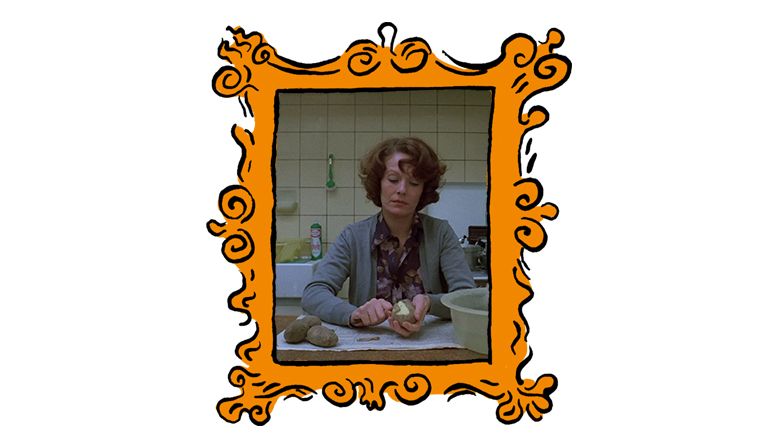It’s not so long ago that Chantal Akerman’s name provoked sniggers. Her best-known film—Jeanne Dielman, 23 Quai du Commerce, 1080 Bruxelles (1975)—had a boring title, was over three hours long and featured interminable scenes of a Belgian housewife chopping up meat. Grist for arthouse masochists? Perhaps it was meant to be a statement about housework. About feminism. It was hard to tell, not least because for ages it wasn’t even available on video or DVD.
As I say in my latest column in the magazine, how times have changed. More and more, younger audiences—many of them female, many sceptical about film canons—are drawn to independent women directors from the 1970s and early 1980s. Directors such as Agnès Varda, Laura Mulvey, Lizzie Borden—and, indeed, Akerman. The marginal has become almost mainstream. In 2022, Jeanne Dielman was voted the “greatest film of all time” by Sight and Sound magazine. Akerman herself is hailed by the likes of Sophia Coppola, Greta Gerwig and Joanna Hogg.
And now, this month and next, the British Film Institute is staging a huge retrospective of her work—as well as releasing two handsome Blu-ray boxsets. Here are my recommendations for anyone who wants to take the opportunity to get into Akerman, beyond Jeanne Dielman…
Saute ma ville (1968)
Akerman made this short after dropping out of film school at the age of 18. She plays a young woman who runs all the way up a block of flats and into her small kitchen where she begins to run amok—dancing, wolfing down noodles, smearing her legs with shoe polish, throwing things on the floor. She hums and groans—like a child, like a loony. Is she having a laugh? A breakdown? She seals the door and lights a flame. There’s a Nouvelle Vague energy here—jump cuts and jittery camerawork—that is unusual for Akerman. The chaos and anarchy of Věra Chytilová’s classic Daisies. The sound design could be from a Yoko Ono art film. Known in English as Blow Up My Town, it’s as troubling as it is unforgettable.
Je Tu Il Elle (1974)
Akerman’s reputation as a fearless and formally rigorous explorer of women’s inner landscapes was secured by this early film. It’s cool, clinical, shockingly ascetic. It’s a triptych in which she herself stars as Julie, a young woman holed up in a room scribbling letters, rearranging furniture and eating spoonfuls of sugar. Then we witness two very different acts of intimacy. The first involves a bored, married lorry driver with whom she unexpectedly hitches a ride. The second is with an ex-lover, a woman. This latter encounter, shot in black and white, is as memorable as the sex scene in Nic Roeg’s Don’t Look Now. It’s deeply carnal, completely unpornographic, liable to make viewers feel like voyeurs. Is Julie lost? Is she on a journey of sexual awakening, of liberation? Akerman offers us the gift of no answers.
News from Home (1977)
Mid-1970s New York spawned many memorable films: Taxi Driver, Annie Hall, Dog Day Afternoon. News from Home, in its eerie, lonesome fashion, is at least as unforgettable. Over a series of lengthy, carefully composed shots of downtown Manhattan, Akerman reads aloud letters her Belgian mother sent to her years earlier. They’re poignant, often needy. But Akerman’s voice itself is rarely emotional. What’s wrong with her? There are few close-ups of local characters. The streets of SoHo seem funereal. Who is the ghost here—the woman or the city? This is a film about exile, about exiles. It closes—prophetically?—with a boat sailing away from the bottom of the island, the megalithic city gradually shrinking, the mist and clouds making the World Trade Center seem a story from the past.
D’Est (1993)
Akerman made documentaries in Tel Aviv, the American South, the US-Mexico border. D’est, shot across three winter trips to Germany, Poland and Russia, captures Eastern Europe after the Cold War, in transition, in the throes of an uncertain future. It has the subdued pacing of a gallery installation, endless tracking shots, scenes of people waiting interminably. Its field labourers might have stepped out of a Georges Seurat painting. Snowscapes. Twilight. It’s a vision of post-Wall Europe that provokes foreboding rather than elation.
No Home Movie (2015)
Akerman’s mother Natalia was an Auschwitz survivor. “The Yellow Star,” the director said, “It is inside of me.” She once told an interviewer: “The only subject of my films is my mother.” There are so many things to think about in this, her last film, which she completed less than a year before taking her own life. Mother and daughter talk—a little, sometimes via laptop, sometimes across each other. About food, the war, the past. There is so much to be said and so little that can be said. Much of this melancholic film is shot in Natalia’s home—but, as the title suggests, even for those who managed to get out of the death camps, there is no home, only an alienation that is permanent.
Akermania is here!
Chantal Akerman’s ‘Jeanne Dielman’ was recently voted the greatest film of all time. This is how to explore more of her work
February 13, 2025










